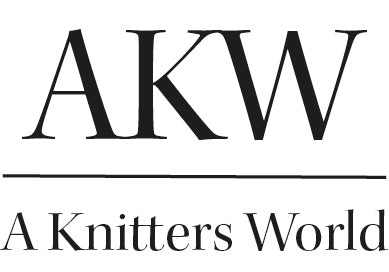
The AKW scale describes how soft/scratchy the yarn is. It can also guide you to find the yarn that suits you best if you are allergic or just slightly sensitive to wool. It helps you find the yarn that suits you best. The scale goes from A - E, where A is absolutely the softest. A Knitters World strives to have yarn primarily from class A, but we have some products that move down to B and C.
A
Soft as butter. Here we recommend winding the yarn by hand and not on a cross-wrench device, as the yarn will have a tendency to fall onto the spool due to the smooth surface of the yarn. The yarn is particularly suitable for wool allergy sufferers and sensitive people. In addition, it will be perfect for people in menopause or just for people who suffer a little with the slightly warmer wool, as they are light yarns often with silk in them, which are not warm to wear. It is recommended to knit it on wooden needles as, among other things, silk can be a little more difficult to control on metal needles and easily slips around and off the needle, especially if you are a beginner with these yarns. The yarn must be washed by hand at a maximum of 30 degrees with wool detergent and must be laid to dry. It is recommended to knit sweaters and t-shirts approx. 3 - 5 cm shorter than what you want it to be, as it often gives a little length after washing and generally after you have worn it. These yarns are often NOT suitable for cutting up, as it is too smooth and will simply unravel even if you crochet or sew inside.
In this class are the following yarns:
- Dark yak
- White yak 50/50
- 100% cashmere
- 50% camel/ 50% silk
- 50% cashmere/ 50% silk
B
The yarn in class B is deliciously soft and most people will be able to tolerate it. However, some people may feel a bit bothered if they are extremely sensitive. If you are in doubt as to whether you can tolerate it, it is a good idea to make a small knitting test and place it in your bra or somewhere close to some thin skin. Go with it for a few days and see if it bothers you. If you have no reactions, the yarn in a finished project will not bother you. Yarns in this group, like in class A, will not be suitable for cutting, as they often contain silk or cashmere, which are fibers that help to soften the yarn. We would also recommend here that you knit your sweater approx. 3 - 5 cm shorter than intended, as the yarn will weigh down and give a little after washing and use. The yarn must be hand washed at a maximum of 30 degrees and tumble dry. Since, as described, they often contain very soft fibers, this yarn is also not suitable for cutting. The yarn here can tease a bit when winding like in class A, so have a little patience or wind it by hand. It is easiest to knit on wooden needles because of the soft fibres, which slide very easily over metal needles and this can make it easy to lose the stitches.
In this class are the following yarns:
- White yak
- 100% yes
- Mink
- Alpaca
- Single merino
- Alpaca sock
- Baby suri alpaca
- Merino/silk
C
Here we are dealing with yarn, which lies in between. This means that if you are allergic to wool, you should try it out by, for example, knitting a test patch and tucking it into your bra, under the arm or at the neck. The yarn here can contain all fibers and some are soft and some are scratchy. But in general, if you are just a little sensitive to wool, you can probably tolerate this yarn, whereas if you are allergic to wool, it is very important to have it tested with this sample cloth. It is easy to wind up on a cross spanner and stick material you don't have to think about either. This yarn is also suitable for pattern knitting and can usually be cut, but it depends on the content of the yarn, so ask about the individual yarn. The yarn is on the softer end, but can be knitted with both wooden and metal needles. I would not immediately cut this yarn, but maybe make a knitting test and see how it reacts. Sometimes it can be done if it is secured on a sewing machine.
In this class are the following yarns:
- Mohair
D
We are about to reach the end of the scale where the slightly scratchier yarn lies. If you are sensitive to wool or allergic, you should not buy yarn from this category. The yarn is easy to wind up on a yarn winder and you can knit with both wooden and metal needles without any problems. The yarn here may become softer after washing, but is still not suitable for wool sensitive or allergy sufferers. It should not immediately be a problem to knit it in the round for, for example, a cardigan and then cut it up, as the fibers ensure that they sit well together. It is particularly suitable for e.g. pattern knitting. The yarn must be machine washed immediately at 30 degrees, but read what the label says, as some can be machine washed.
In this class are the following yarns:
E
Very scratchy and definitely not for the wool sensitive or allergy sufferers. This yarn often contains 100% wool of some kind. Sometimes there is more lanolin in these yarns, which is often what wool allergy sufferers react to. The yarn is usually very light, airy and slightly thicker in it and is suitable for thick sweaters and it is often knitted on the slightly thicker needles. It gives some sweaters a thick and very warm feel and is therefore suitable for people who get colder or for people who live outdoors. This yarn is no problem to wind up on a cross key apparatus. Some of this yarn can be machine washed and some must be hand washed, so it is therefore important that you read on the product you have bought about what they recommend. It is good for pattern knitting and perfect for cutting up for e.g. cardigans etc. This yarn can be knitted with both wooden and metal needles.
In this class are the following yarns:

